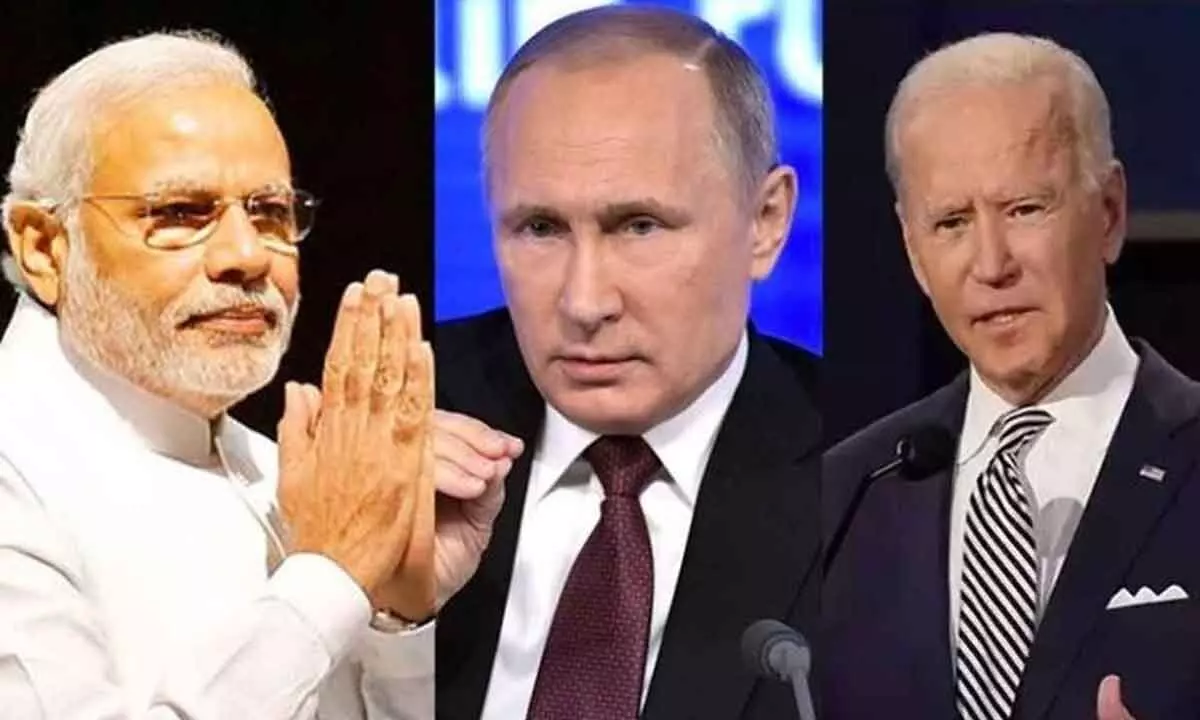Keeping arch-rivals Russia and the US in good humour calls for a diplomatic balancing act
Both India and China have increased purchases of Russian oil at rates post-Ukraine invasion
image for illustrative purpose

Enhancing trade and economic cooperation between India and Russia is a key priority for the political leadership of both nations. This is made clear by the revised targets of increasing bilateral investment to $ 50 billion and bilateral trade to $ 30 billion by 2025.
As per Indian figures, bilateral trade during April 2020-March 2021 amounted to $ 8.1 billion. Indian exports amounted to $ 2.6 billion while imports from Russia amounted $ 5.48 billion. For the same period, as per Russian figures, bilateral trade amounted to $ 9.31 billion, with Indian exports amounting to $ 3.48 billion and imports put at $ 5.83 billion.
India is also contemplating an FTA/ CECA with the Eurasian Economic Union (EEU), which is one of the important emerging economic blocks. India is keen to engage more closely with Russia and the CIS countries to further intensify trade and economic cooperation with this region.
Russia’s economy is highly dependent on exports of commodities with revenues from sale of crude oil, petroleum products and natural gas accounting for about a half of Russia’s federal budget. Its main exports are: fuels and energy products (63 per cent of total shipments, of which crude oil and natural gas accounted for 26 per cent and 12 per cent respectively); metals (10 per cent); machinery and equipment (7.4 per cent); chemical products (7.4 per cent) and foodstuffs and agricultural products (five per cent).
China has been the leading export destination of fossil fuels from Russia since the start of the invasion of Ukraine on February 24, 2022. Since that date, Russia has exported fossil fuels, such as oil, natural gas, and coal, worth around 97 billion euros to China as of August 7, 2023. Turkey was the second leading recipient country, with a total fossil fuel export value of approximately 38.3 billion euros.
Both China and India have increased their purchases of Russian oil in the wake of Moscow’s invasion of Ukraine, benefiting from discounted rates. India’s crude oil imports from Russia hit a record 680.7 percent growth rate last year. According to a report by S&P Global Commodity Insights, India is likely to continue importing large volumes of Russian crude oil this year. While Russia’s revenues from fossil fuel exports have declined significantly since their peak in March of 2022, many countries are still importing millions of dollars a day worth of fossil fuels from Russia.
Revenue from fossil fuels exported to the EU has declined more than 90% from their peak, but in 2023 the bloc has still imported more than $18 billion of crude oil and natural gas so far.
China continues to be Russia’s top buyer of fossil fuels, with imports reaching $30 billion in 2023 up until June 16, 2023.
With nearly 80% of China’s fuel imports being crude oil, Russia’s average daily revenues from Chinese fossil fuel imports declined from $210 million in 2022 to $178 million in 2023 largely due to the falling price of Russian crude oil. Russia had supplied India with $13 billion worth of arms in the past five years. India has also placed a requisition for another $10 billion worth of arms and military equipment with Russia. India’s procurement accounts for 20% of Russia’s defence exports.
Despite the unprecedented pressure on India from Western countries led by the United States in connection with Russia’s special operation in Ukraine, it continues to be one of Russia’s main partners in the field of military-technical cooperation.
The annual arms exports were about $14-15 billion, and the order book has remained steady at around $50 billion, Interfax reported.
Russia’s clientele for defence equipment in Asia is particularly drawn to S-400 Triumf missile defence systems; short-range surface-to-air missiles systems, such as the Osa, Pechora or Strela; as well as Su-30 warplanes, MiG-29 helicopters and drones.
Some of the biggest importing countries, even if they are willing, will find it difficult to withstand pressures from Europe and the U.S. to consider buying whatever little we have to offer by way of major equipment and platforms.
Lower costs of fuel, defence ally against China and Pakistan and imports of critical defence equipment are key takeaways for India. Russia could also be an important market for Indian exports and space cooperation. But aligning with Russia could distance itself from the US and Western countries. Many key Asian countries could find a conflict of interest in India’s relationship with Russia.

